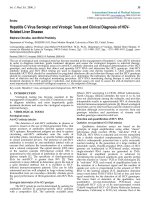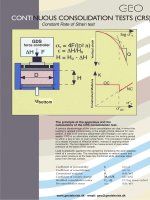Allergy tests
Bạn đang xem bản rút gọn của tài liệu. Xem và tải ngay bản đầy đủ của tài liệu tại đây (614.42 KB, 14 trang )
Allergy tests
Raccoon
Eyes
Fatigue
Depression
Chronic Congestion
The Allergic Salute
Hives
Wheezing
Trouble Concentrating
Itchy Skin
Insomnia
Common symptoms of allergy
•Nose: swelling of the nasal mucosa
•Sinuses: allergic sinusitis
•Eyes: redness and itching of the
conjunctiva
•Airways: sneezing, coughing, Wheezing,
asthma, laryngeal edema
•Ears: feeling of fullness
•Skin: rashes
•Gastrointestinal tract: abdominal pain,
bloating, vomiting, diarrhea
cause
• Ingested allergens: Foods (peanut,
milk, soy, wheat, chicken ,egg , beef,
seafood, chesses , vegetables, fruits, …)
• Inhalant allergens: Pet danders, dust
mites, mold spores, pollen,cockroaches
• Other allergens: latex, drugs, insect
stings
Pollen
Molds
Foods
Animal Dander
Cockroaches
Medication
Fragrance
Dust Mites
Insect Stings
Latex
•
•
•
•
Immediate hypersensitivities
Antibody- mediated cytotoxicity
Immune complex disorders
Cell-Mediated hypersensitivities
ALLERGY TEST
•
•
•
Skin test:
– skin prick test.
– Intradermal test.
– Patch test
Blood tests: RAST, specific IgE antibodies level, elisa…
Other tests:
Elimination type tests
Unproven allergy tests :
–
–
–
–
–
–
–
–
Cytotoxic testing
Provocation- neutralization
Electrodermal diagnosis
Kinesiology
Reaginic pulse
Body chemical analysis
Measurement of IgG antibodies
Histamine release assays
Contraindications for skin test
• History of anaphylaxis
• High risk of anaphylactic reaction to testing(
poor controlled asthma, reduced lung function,
history of severe reaction to minute amounts of
allergens)
• Rashes, acute skin injection
• Can not stop medication
• Cardiovascular disease( coronary artery, cardiac
arrhythmias)
Skin prick test
•
•
•
•
•
•
•
•
The first choice
Simple, quick, safe, sensitive, inexpensive
Indentify inhaled allergens, ingested allergens, determine whether a person may be
allergic to a medicine or insect venom
Place drops of the possible allergen on the skin
Prick the skin under each drop with a needle
Check the skin after 12 to 15 minutes for red, raised itchy areas called wheals
The rate of systemic reactions to skin prick testing was 0,001%
If skin prick test negative: choose intradermal test at a later visit
Intradermal test
• The intradermal test is sensitive more than the skin prick
test
• A small amount of the allergen solutions is injected into
the skin
Patch test
• Doses of the allergens are placed on the
patches that look like adhesive bandages
• Wear the patches for 24 to 72 hours, no bath, no
exercise
• Contact dermatitis
Blood test( immunoassay)
• Measure the mount of specific IgE, RAST, elisa
• When?
-Rick of an anaphylaxis.
-Rash(hives, eczema).
-Can not stop taking a medicine( antihistamine, tricycle
antidepressant, beta blocker, ACE inhibitor,
immunomodulatory creams, topical steroids)
-unusual and rare allergens are suspected
• Less sensitive than skin test
• Cost more than skin test
IDENTIFY POSITIVE TEST
• Positive skin test: a wheal created by the allergen
is at least 3mm larger than the reaction to the negative
control
• Positive blood test: the levels of immunoglobulin
IgE antibodies for a particular allergen or group of
allergens are four times the normal level
Thank you









